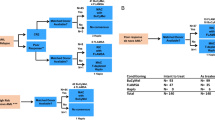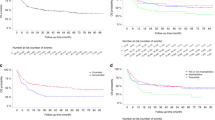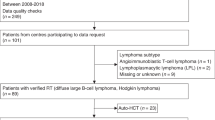Abstract
More than 80% of children with ALL are now cured with chemotherapy without need for transplantation. This remarkable progress is the result of serial large-scale randomized clinical trials incorporating improvements in risk group assignment, administration of risk-adjusted therapy and intensified therapy for children with high-risk disease. Despite these advances, significant numbers of children still die of relapsed or refractory ALL, as ALL is the most frequent malignancy of childhood. This review focuses on the appropriate use of transplantation for children with ALL and optimization of transplant procedures to improve survival and reduce late consequences of therapy.
This is a preview of subscription content, access via your institution
Access options
Subscribe to this journal
Receive 12 print issues and online access
$259.00 per year
only $21.58 per issue
Buy this article
- Purchase on Springer Link
- Instant access to full article PDF
Prices may be subject to local taxes which are calculated during checkout
Similar content being viewed by others
References
Schultz KR, Pullen DJ, Sather HN, Shuster JJ, Devidas M, Borowitz MJ et al. Risk-and response-based classification of childhood B-precursor acute lymphoblastic leukemia: a combined analysis of prognostic markers from the Pediatric Oncology Group (POG) and Children's Cancer Group (CCG). Blood 2007; 109: 926–935.
Aricò M, Valsecchi MG, Camitta B, Schrappe M, Chessell J, Baruchel A et al. Outcome of treatment in children with Philadelphia chromosome-positive acute lymphoblastic leukemia. N Engl J Med 2000; 342: 998–1006.
Marks DI, Bird JM, Cornish JM, Goulden NJ, Jones CG, Knechtli CJ et al. Unrelated donor bone marrow transplantation for children and adolescents with Philadelphia-positive acute lymphoblastic leukemia. J Clin Oncol 1998; 16: 931–936.
Sierra J, Radich J, Hansen JA, Martin PJ, Petersdorf EW, Bjerke J et al. Marrow transplants from unrelated donors for treatment of Philadelphia chromosome-positive acute lymphoblastic leukemia. Blood 1997; 90: 1410–1414.
Roy A, Bradburn M, Moorman AV, Burrett J, Love S, Kinsey SE et al. Early response to induction is predictive of survival in childhood Philadelphia chromosome positive acute lymphoblastic leukaemia: results of the Medical Research Council ALL 97 trial. Br J Haematol 2005; 129: 35–44.
Talano JM, Casper JT, Camitta BM, Keever-Taylor CA, Murray KJ, Eapen M et al. Alternative donor bone marrow transplant for children with Philadelphia chromosome ALL. Bone Marrow Transplant 2006; 37: 135–141.
Eapen M, Rubinstein P, Zhang MJ, Stevens C, Kurtzberg J, Scaradavo A et al. Outcomes of transplantation of unrelated donor umbilical cord blood and bone marrow in children with acute leukaemia: a comparison study. Lancet 2007; 369: 1947–1954.
Wassmann B, Pfeifer H, Goekbuget N, Beelen DW, Beck J, Stelljes M et al. Alternating versus concurrent schedules of imatinib and chemotherapy as front-line therapy for Philadelphia-positive acute lymphoblastic leukemia (Ph+ ALL). Blood 2006; 108: 1469–1477.
Carpenter PA, Snyder DS, Flowers ME, Sanders JE, Gooley Ta, Martin PJ et al. Prophylactic administration of imatinib after hematopoietic cell transplantation for high-risk Philadelphia chromosome-positive leukemia. Blood 2007; 109: 2791–2793.
Heerema NA, Nachman JB, Sather HN, Sensel MG, Lee MK, Hutchinson R et al. Hypodiploidy with less than 45 chromosomes confers adverse risk in childhood acute lymphoblastic leukemia: a report from the Children's Cancer Group. Blood 1999; 94: 4036–4046.
Nachman JB, Heerema NA, Sather H, Camitta B, Forestier E, Harrison CJ et al. Outcome of treatment in children with hypodiploid acute lymphoblastic leukemia. Blood 2007; 110: 1112–1115.
Conter V, Aricò M, Valsecchi MG, Basso G, Biondi A, Madon E et al. Long-term results of the Italian Association of Pediatric Hematology and Oncology (AIEOP) Acute Lymphoblastic Leukemia Studies, 1982–1995. Leukemia 2000; 14: 2196–2204.
Satwani P, Sather H, Ozkaynak F, Heerema NA, Schultz KR, Sanders J et al. Allogenic bone marrow transplantation in first remission for children with ultra-high-risk features of acute lymphoblastic leukemia: a children's oncology group study report. Biol Blood Marrow Transplant 2007; 13: 218–227.
Bordigoni P, Vernant JP, Souillet G, Gluckman E, Marininchi D, Milpied N et al. Allogeneic bone marrow transplantation for children with acute lymphoblastic leukemia in first remission: a cooperative study of the Groupe d'Etude de la greffe de Moelle Osseuse. J Clin Oncol 1989; 7: 747–753.
Chao NJ, Forman SJ, Schmidt GM, Snyder DS, Amylon MD, Konrad PN et al. Allogeneic bone marrow transplantation for high-risk acute lymphoblastic leukemia during first complete remission. Blood 1991; 78: 1923–1927.
Borgmann A, Baumgarten E, Schmid H, Dopfer R, Ebell W, Gobel U et al. Allogeneic bone marrow transplantation for a subset of children with acute lymphoblastic leukemia in third remission: a conceivable alternative? Bone Marrow Transplant 1997; 20: 939–944.
Afify Z, Hunt L, Green A, Guttridge M, Cornish J, Oakhill A et al. Factors affecting the outcome of stem cell transplantation from unrelated donors for childhood acute lymphoblastic leukemia in third remission. Bone Marrow Transplant 2005; 35: 1041–1047.
Borowitz MJ, Pullen DJ, Shuster JJ, Viswanatha D, Montgomery K, William CL et al. Minimal residual disease detection in childhood precursor-B-cell acute lymphoblastic leukemia: relation to other risk factors. A Children's Oncology Group study. Leukemia 2003; 17: 1566–1572.
Nyvold C, Madsen HO, Ryder LP, Seyfarth J, Svejgaad A, Clausen N et al. Precise quantification of minimal residual disease at day 29 allows identification of children with acute lymphoblastic leukemia and excellent outcome. Blood 2002; 99: 1253–1258.
Dworzak MN, Froschi G, Printz D, Mann G, Potschger U, Muhlegger N et al. Prognostic significance and modalities of flow cytometric minimal residual detection in childhood acute lymphoblastic leukemia. Blood 2002; 15: 1952–1958.
Tarusawa M, Yashima A, Endo M, Maesawa C . Quantitative assessment of minimal residual disease in childhood lymphoid malignancies using an allele-specific oligonucleotide real-time quantitative polymerase chain reaction. Int J Hematol 2002; 75: 166–173.
Willlemse MJ, Seriu T, Hetteringer K, d'Aniello E, Hop WC, Panzer-Grumayer ER et al. Detection of minimal residual disease identifies differences in treatment response between T-ALL and precursor B-ALL. Blood 2002; 15: 4386–4393.
Coustan-Smith E, Sancho J, Behm FG, Hancock ML, Razzouk BI, Ribeiro RC et al. Prognostic importance of measuring early clearance of leukemia cell by flow cytometry in childhood acute lymphoblastic leukemia. Blood 2002; 100: 52–58.
Ross ME, Zhou X, Song G, Shurleff SA, Girtman K, Williams WK et al. Classification of pediatric acute lymphoblastic leukemia by gene expression profiling. Blood 2003; 102: 2951–2959.
Haferlach T, Kohlmann A, Schnittger S, Dugas M, Hiddemann W, Kern W et al. Global approach to the diagnosis of leukemia using gene expression profiling. Blood 2005; 106: 1189–1198.
Hollerman A, Cheok MH, den Boer ML, Yang W, Veerman AJ, Kazemier KM et al. Gene-expression patterns in drug-resistant acute lymphoblastic leukemia cells and response to treatment. N Engl J Med 2004; 351: 601–603.
Flotho C, Coustan-Smith E, Pei D, Cheng C, Song G, Pui CH et al. A set of genes that regulate cell proliferation predicts treatment outcome in childhood acute lymphoblastic leukemia. Blood 2007; 110: 1271–1277.
Uzunel M, Jaksch M, Mattsson J, Ringden O . Minimal residual disease detection after allogeneic stem cell transplantation is correlated to relapse in patients with acute lymphoblastic leukemia. Br J Haematol 2003; 122: 788–794.
Schilham MW, Balduzzi A, Bader P . PD-WP of the EBMT. Bone Marrow Transplant 2005; 1: 49–52.
Sramkova L, Muzikova K, Fronkova E, Krejci O, Sedlacek P, Formankova R et al. Detectable minimal residual disease before allogeneic hematopoietic stem cell transplantation predicts extremely poor prognosis in children with acute lymphoblastic leukemia. Pediatric Blood Cancer 2007; 48: 93–100.
Chen CS, Sorensen HB, Domer PH, Reaman GH, Korsmeyer SJ, Heerema NA et al. Molecular rearrangements on chromosome 11q23 predominate in infant acute lymphoblastic leukemia and are associated with specific biologic variable and poor outcome. Blood 1993; 81: 2386–2393.
Pui CH, Behm FG, Downing JR, Hancock ML, Shurleff SA, Riberiro RC et al. 11q23/MLL rearrangement confers a poor prognosis in infants with acute lymphoblastic leukemia. J Clin Oncol 1994; 12: 909–915.
Pui C-H, Gaynon PS, Boyett JM, Chessells JM, Baruchel A, Kamps W et al. Outcome of treatment in childhood acute lymphoblastic leukaemia with rearrangements of the 11q23 chromosomal region. Lancet 2002; 359: 1909–1915.
Sanders JE, IM HJ, Hoffmeister PA, Gooley TA, Woolfrey AE, Carpenter PA et al. Allogeneic hematopoietic cell transplantation for infants with acute lymphoblastic leukemia. Blood 2005; 105: 3749–3756.
Pieters R, Schrappe M, De Lorenzo P, Hann I, De rossi G, Felice M et al. A treatment protocol for infants younger than 1 year with acute lymphoblastic leukaemia (Interfant-99): an observational study and a multicentre randomised trial. Lancet 2007; 370: 240–250.
Eapen M, Raetz E, Zhang M, Muehlenbein C, Devidas M, Abshire T et al. Outcomes after HLA-matched sibling transplantation or chemotherapy in children with B-precursor acute lymphoblastic leukemia in a second remission: a collaborative study of the Children's Oncology Group and the Center for International Blood and Marrow Transplant Research. Blood 2006; 107: 4961–4967.
Uderzo C, Valsecchi MG, Bacigalupo A, Meloni G, Messina C, Polchi P et al. Treatment of childhood acute lymphoblastic leukemia in second remission with bone marrow transplantation and chemotherapy: ten year experience of the Italian Bone Marrow Transplantation Group and the Italian Pediatric Hematology Oncology Association. J Clin Oncol 1995; 134: 352–358.
Dopfer R, Henze G, Bender-Gotze C, Ebell W, Ethniger G, Friedrich W et al. Allogeneic bone marrow transplantation for childhood acute lymphoblastic leukemia in second remission after intensive primary and relapse therapy according to the BFM- and CoALL-protocols: results of the German Cooperative Study. Blood 1991; 78: 2780–2784.
Davies SM, Ramsay NK, Klein JP, Weisdorf DJ, Bolwell B, Cahn JY et al. Comparison of preparative regimens in transplants for children with acute lymphoblastic leukemia. J Clin Oncol 2000; 18: 340–347.
Bunin N, Aplenc R, Kamani N, Shaw K, Cnaan A, Simms S et al. Randomized trial of busulfan vs total body irradiation containing conditioning regimens for children with acute lymphoblastic leukemia: a Pediatric Blood and Marrow Transplant Consortium study. Bone Marrow Transplant 2003; 32: 543–548.
Marks DI, Forman SJ, Blume KG, Perez WS, Weisdorf DJ, Keating A et al. A comparison of cyclophosphamide and total body irradiation with etoposide and total body irradiation as conditioning regimens for patients undergoing sibling allografting for acute lymphoblastic leukemia in first or second complete remission. Biol Blood Marrow Transplant 2006, 438–453.
Barker JN, Krepski TP, DeFor TLE, Davies SM, Wagner JE, Weisdorf DJ et al. Searching for unrelated donor hematopoietic stem cells: availability and speed of umbilical cord blood versus bone marrow. Biol Blood Marrow Transplant 2002; 8: 257–260.
Bordigoni P, Vernant JP, Souillet G, Gluckman E, Marinichi D, Milpied N et al. Allogeneic bone marrow transplantation for children with acute lymphoblastic leukemia in first remission: a cooperative study of the Groupe D'Etude de la Greffe de Moelle Osseuse. J Clin Oncol 1989; 7: 747–753.
Von Bueltzingslowen A, Esperou-Bourdea H, Souillet G, Demeocq F, Mechinaud-Lacroix F, Michel G et al. Allogeneic bone marrow transplantation following a busulfan based conditioning regimen in young children with acute lymphoblastic leukemia: a Cooperative Study of the Societe Francaise de Greffe de Moelle. Bone Marrow Transplant 1995; 16: 521–527.
Saarinen UM, Mellander L, Nysom K, Ringden O, Schroeder H, Glomstein A et al. Allogeneic bone marrow transplantation in first remission for children with very high-risk acute lymphoblastic leukemia: a retrospective case–control study in the Nordic countries. Nordic society for Pediatric Hematology and Oncology (NOPHO). Bone Marrow Transplant 1996; 17: 357–363.
Chessells JM, Baily C, Wheeler K, Richards SM . Bone marrow transplantation for high-risk childhood lymphoblastic leukaemia in first remission: experience in MRC UKALL X. Lancet 1992; 340: 565–568.
Balduzzi A, Valsecchi M, Uderzo C, De Lorenzo P, klingebiel T, Peters C et al. Chemotherapy versus allogeneic transplantation for very high-risk childhood acute lymphoblastic leukaemia in first complete remission: comparison by genetic randomisation in an international prospective study. Lancet 2005; 366: 635–642.
Ribera J, Ortega J, Oriol A, Bastida P, Calvo C, Pérez-Hurtado J et al. Comparison of intensive chemotherapy, allogeneic, or autologous stem-cell transplantation as post remission treatment for children with very high risk acute lymphoblastic leukemia: PETHEMA ALL-93 Trial. J Clin Oncol 2007; 25: 16–24.
Sanders JE, Thomas ED, Buckner CD, Doney K . Marrow transplantation for children with acute lymphoblastic leukemia in second remission. Blood 1987; 70: 324–326.
Brochstein JA, Kernan NA, Groshen S, Cirrincione C, Shank B, Emanuel D et al. Allogeneic bone marrow transplantation after hyperfractionated total-body irradiation and cyclophosphamide in children with acute leukemia. N Engl J Med 1987; 317: 618–624.
Woods WG, Nesbit ME, Ramsay NK, Krivit W, Kim TH, Goldman A et al. Intensive therapy followed by bone marrow transplantation for patients with acute lymphocytic leukemia in second or subsequent remission: determination of prognostic factor (a report from the University of Minnesota Bone Marrow Transplantation Team). Blood 1983; 6: 1182–1189.
Weisdorf DJ, Woods WG, Nesbit ME JR, Uckun F, Dusenbery K, Haake R et al. Allogeneic bone marrow transplantation for acute lymphoblastic leukemia: risk factors and clinical outcomes. Br J Haematol 1994; 86: 62–69.
Parson SK, Casellino SM, Lehmann LE, Eickhoff CE, Tarbell NJ, Sallan SE et al. Relapsed acute lymphoblastic leukemia: similar outcomes for autologous and allogeneic marrow transplantation in selected children. Bone Marrow Transplant 1996; 17: 763–768.
Carpenter PA, Marshall GM, Giri N, Vowels MR, Russell SJ . Allogeneic bone marrow transplantation for children with acute lymphoblastic leukemia condition with busulfan, cyclophosphamide and melphalan. Bone Marrow Transplant 1996; 18: 489–494.
Boulad F, Steinherz P, Reyes B, Heller G, Gillio P, Small TN et al. Allogeneic bone marrow transplantation versus chemotherapy for the treatment of childhood acute lymphoblastic leukemia in second remission: a single-institution study. J Clin Oncol 1999; 17: 197–207.
Bleakley M, Shaw PJ, Nielsen JM . Allogeneic bone marrow transplantation for childhood relapsed acute lymphoblastic leukemia: comparison of outcome in patients with and without a matched family donor. Bone Marrow Transplant 2002; 30: 1–7.
Weyman C, Graham-Pole J, Emerson S, August C, Champlin R, Coccia P et al. Use of cytosine arabinoside and total body irradiation as conditioning for allogeneic marrow transplantation in patients with acute lymphoblastic leukemia. Bone Marrow Transplant 1993; 11: 43–50.
Green A, Clarke E, Hunt L, Canterbury A, Lankester A, Hale G et al. Children with acute lymphoblastic leukemia who receive T-cell-depleted HLA mismatched marrow allografts from unrelated donors have an increased incidence of primary graft failure but a similar overall transplant outcome. Blood 1999; 94: 2236–2246.
Woolfrey AE, Anasetti C, Storer B, Doney K, Milner LA, Sievers EL et al. Factors associated with outcome after unrelated marrow transplantation for treatment of acute lymphoblastic leukemia in children. Blood 2002; 99: 2002–2008.
Bunin N, Carston M, Wall D, Adams R, Casper J, Kamani N et al. Unrelated marrow transplantation for children with acute lymphoblastic leukemia in second remission. Blood 2002; 99: 3151–3157.
Borgmann A, von Stackelberg A, Hartmann R, Ebell W, Klingebiel T, Peters C et al. Unrelated donor stem cell transplantation compared with chemotherapy for children with acute lymphoblastic leukemia in a second remission: a matched-pair analysis. Blood 2003; 101: 3835–3839.
Author information
Authors and Affiliations
Corresponding author
Rights and permissions
About this article
Cite this article
Mehta, P., Davies, S. Allogeneic transplantation for childhood ALL. Bone Marrow Transplant 41, 133–139 (2008). https://doi.org/10.1038/sj.bmt.1705914
Received:
Revised:
Accepted:
Published:
Issue Date:
DOI: https://doi.org/10.1038/sj.bmt.1705914
Keywords
This article is cited by
-
Monitoring minimal residual disease in children with high-risk relapses of acute lymphoblastic leukemia: prognostic relevance of early and late assessment
Leukemia (2015)
-
Clinical and In Vitro Studies on Impact of High-Dose Etoposide Pharmacokinetics Prior Allogeneic Hematopoietic Stem Cell Transplantation for Childhood Acute Lymphoblastic Leukemia on the Risk of Post-Transplant Leukemia Relapse
Archivum Immunologiae et Therapiae Experimentalis (2015)
-
Long-term results of NOPHO ALL-92 and ALL-2000 studies of childhood acute lymphoblastic leukemia
Leukemia (2010)
-
B-cell reconstitution after allogeneic SCT impairs minimal residual disease monitoring in children with ALL
Bone Marrow Transplantation (2008)
-
Relapsed acute lymphoblastic leukemia: Current status and future opportunities
Current Oncology Reports (2008)



